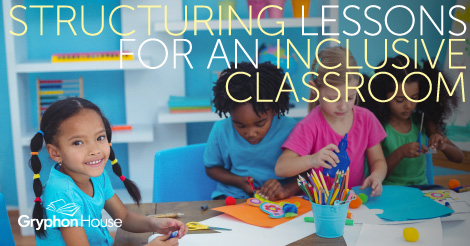
The task of creating an inclusive classroom may seem daunting to some teachers. Many are unsure of how to accommodate students with learning disabilities or how to implement special education into their early childhood curriculums. However, creating an inclusion classroom is not as hard as it seems.
The Inclusive Early Childhood Classroom, by Patti Gould and Joyce Sullivan, is a wonderful resource for teacher strategies on how to adapt and improve your classroom and lesson plans to include all learners. Every young child deserves a nurturing and stimulating environment in which to learn, and that can be achieved with a few easy and beneficial modifications to your classroom.
Understanding differences in terms of behaviors and needs amongst your students is key to ensuring the success of those with and without special needs. Modifications can be made to any lesson plan or learning center, creating different ways to do typical activities, allowing all students to participate.
Here are some strategies for developing lesson plans and a curriculum accessible to all students in your inclusive classroom.
Circle Time
- Most three-year-olds and many four-year-olds are not developmentally ready to sit and listen to a group activity for longer than just a few minutes. Circle time activities that incorporate music and movement usually hold children’s attention for longer periods of time than a sit-and-listen type of activity.
- Although the traditional circle time includes all the children in the classroom, you might want to consider other options. For instance, make circle time an activity center, and like other play centers, give children the option of joining. Or run two circle times of eight children instead of one large circle time of sixteen.
- Most young children need some degree of consistency and structure, but children with behavioral issues, PDD, autism, developmental delays, motor-planning problems, and visual impairments need it even more. Providing these children with a regular circle time routine allows them to feel comfortable and in control of the world around them.
Art Center
- Typically developing children will move through the art stages with little or no adult instruction, but children with special needs will probably need your help along the way. The child that is functioning at a lower developmental level than his peers might have some skills that are age appropriate and others that are not. Always accept what the child is able to produce as his current developmental level while still trying to move him on to the next stage. Remember that it takes many repetitions for the child with developmental delays to fully learn a new skill.
- Encourage the child with developmental delays to participate in open-ended art activities. Use demonstration, task breakdown and hand-over-hand assistance as needed.
- For the child with weak hand muscles and a poor grasp, short, stubby writing implements are frequently easier to grasp than commercially available crayons, markers, and brushes. Break chalk, crayon cookies, and chunky (preschool) crayons into short segments, and “fatten up” the handles of markers and brushes.
Author(s)Joyce Sullivan, Patti Gould
Anna Wilmoth
Marketer. Publisher. Reporter. Educator. Mother. Runner. Explorer. Anna served as director of marketing for Gryphon House from Oct 2014 - May 2017.

